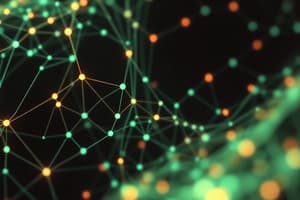Podcast
Questions and Answers
What is the role of the input layer in a neural network?
What is the role of the input layer in a neural network?
- Receive data from external sources (correct)
- Analyze and process the data
- Determine whether a node should activate
- Provide the results
Which layer in a neural network is responsible for analyzing and processing the data?
Which layer in a neural network is responsible for analyzing and processing the data?
- Activation function
- Input layer
- Output layer
- Hidden layer(s) (correct)
What determines whether a node should activate in a neural network?
What determines whether a node should activate in a neural network?
- Activation function (correct)
- Results provided by the output layer
- Analysis by the input layer
- Data received from external sources
In which type of learning is the neural network provided with labeled training samples?
In which type of learning is the neural network provided with labeled training samples?
What is the main focus of unsupervised learning in neural networks?
What is the main focus of unsupervised learning in neural networks?
Which example illustrates supervised learning in neural networks?
Which example illustrates supervised learning in neural networks?
What is one of the applications of neural networks mentioned in the text?
What is one of the applications of neural networks mentioned in the text?
Which application is NOT mentioned as a current use of neural networks?
Which application is NOT mentioned as a current use of neural networks?
When did the concept of neural networks first originate?
When did the concept of neural networks first originate?
What is a potential future application of neural networks according to the text?
What is a potential future application of neural networks according to the text?
How do neural networks generate reliable predictions in financial markets?
How do neural networks generate reliable predictions in financial markets?
What is NOT mentioned as an impact of neural networks on society?
What is NOT mentioned as an impact of neural networks on society?
Flashcards are hidden until you start studying
Study Notes
Neural Networks
Introduction
Neural networks are a type of machine learning model that imitates the way the human brain processes information. Inspired by the neuron structure and connections within the human brain, neural networks consist of multiple layers of artificial nodes that process and transform raw data into valuable insights. They play a crucial role in various applications across industries, such as computer vision, speech recognition, natural language processing, and recommendation systems.
Key Components
Neural networks are composed of four main layers: input layer, hidden layer(s), output layer, and activation function. The input layer receives data from external sources, while the hidden layer(s) analyze and process the data. Finally, the output layer provides the results, and the activation function determines whether a node should activate or not based on certain conditions.
Supervised and Unsupervised Learning
Neural networks can be classified into two types based on how they are trained: supervised and unsupervised learning. In supervised learning, the network is provided with labeled training samples, enabling it to learn and make accurate predictions. On the other hand, unsupervised learning involves training the network without labeled data, requiring it to discover patterns within the data.
Supervised Learning Example
An example of supervised learning is the training of a neural network to accurately predict stock prices. The network is provided with historical data containing various factors affecting the market, such as company performance, economic indicators, and public opinion polls. Through the use of supervised learning techniques, the network is able to establish correlations between these factors and stock price trends, enabling it to generate reliable predictions.
Historical Development and Current Applications
The concept of neural networks dates back to 1944, when Warren McCullough and Walter Pitts first proposed the idea. Since then, neural networks have undergone multiple periods of popularity and decline due to advancements in computing power and research interests.
Today, neural networks are widely used in various applications such as:
- Computer vision: Recognizing objects and understanding visual contexts in images and videos
- Speech recognition: Analyzing human speech patterns for better interaction with virtual assistants like Google Assistant or Apple's Siri
- Natural language processing: Gathering insights from text data by comprehending human-generated content
- Recommendation systems: Personalizing recommendations based on user behavior and preferences
- Medical diagnosis: Classifying medical images for accurate diagnoses
- Targeted advertising: Filtering social media feeds and user behavior analysis to target specific users with relevant ads
- Financial predictions: Processing historical financial market data to make accurate forecasts
Future Possibilities
Neural networks continue to evolve and expand their capabilities. Some potential future applications include:
- Replacing traditional search engines with more intuitive domain-specific ones that can understand complex queries and provide accurate results
- Improving machine learning algorithms by incorporating emotional intelligence into AI models
- Enhancing scientific discovery by enabling computers to analyze vast amounts of data and identify previously unknown correlations
Conclusion
Neural networks represent a significant leap forward in artificial intelligence, offering a glimpse into the future where machines will be able to process information and learn just like humans do. As technology continues to advance, neural networks will likely become even more sophisticated, further expanding their impact across industries and society as a whole.
Studying That Suits You
Use AI to generate personalized quizzes and flashcards to suit your learning preferences.




